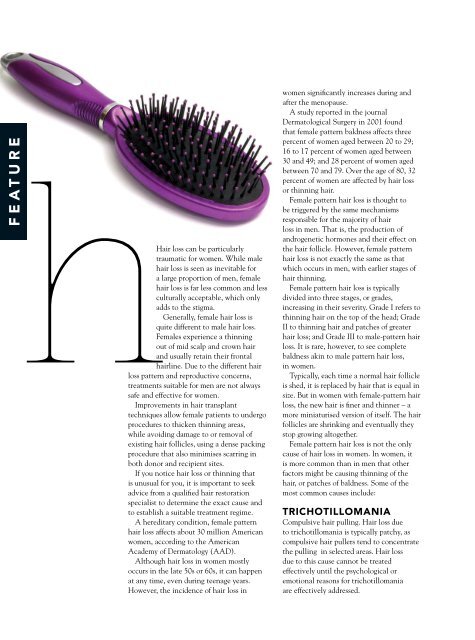CosBeauty Magazine #87
CosBeauty is the #BeautyAddict's guide to lifestyle, health and beauty in Australia. In this issue: - Get the Goss on Gloss - Celebrity Style on the 2020 Red Carpet - The Mane Attraction: Best of the best for your crowning glory - Summer Skin SOS Plus all of the usually features on makeup, skincare, aesthetic medicine and beauty.
CosBeauty is the #BeautyAddict's guide to lifestyle, health and beauty in Australia.
In this issue:
- Get the Goss on Gloss
- Celebrity Style on the 2020 Red Carpet
- The Mane Attraction: Best of the best for your crowning glory
- Summer Skin SOS
Plus all of the usually features on makeup, skincare, aesthetic medicine and beauty.
You also want an ePaper? Increase the reach of your titles
YUMPU automatically turns print PDFs into web optimized ePapers that Google loves.
feature<br />
hHair loss can be particularly<br />
traumatic for women. While male<br />
hair loss is seen as inevitable for<br />
a large proportion of men, female<br />
hair loss is far less common and less<br />
culturally acceptable, which only<br />
adds to the stigma.<br />
Generally, female hair loss is<br />
quite different to male hair loss.<br />
Females experience a thinning<br />
out of mid scalp and crown hair<br />
and usually retain their frontal<br />
hairline. Due to the different hair<br />
loss pattern and reproductive concerns,<br />
treatments suitable for men are not always<br />
safe and effective for women.<br />
Improvements in hair transplant<br />
techniques allow female patients to undergo<br />
procedures to thicken thinning areas,<br />
while avoiding damage to or removal of<br />
existing hair follicles, using a dense packing<br />
procedure that also minimises scarring in<br />
both donor and recipient sites.<br />
If you notice hair loss or thinning that<br />
is unusual for you, it is important to seek<br />
advice from a qualified hair restoration<br />
specialist to determine the exact cause and<br />
to establish a suitable treatment regime.<br />
A hereditary condition, female pattern<br />
hair loss affects about 30 million American<br />
women, according to the American<br />
Academy of Dermatology (AAD).<br />
Although hair loss in women mostly<br />
occurs in the late 50s or 60s, it can happen<br />
at any time, even during teenage years.<br />
However, the incidence of hair loss in<br />
women significantly increases during and<br />
after the menopause.<br />
A study reported in the journal<br />
Dermatological Surgery in 2001 found<br />
that female pattern baldness affects three<br />
percent of women aged between 20 to 29;<br />
16 to 17 percent of women aged between<br />
30 and 49; and 28 percent of women aged<br />
between 70 and 79. Over the age of 80, 32<br />
percent of women are affected by hair loss<br />
or thinning hair.<br />
Female pattern hair loss is thought to<br />
be triggered by the same mechanisms<br />
responsible for the majority of hair<br />
loss in men. That is, the production of<br />
androgenetic hormones and their effect on<br />
the hair follicle. However, female pattern<br />
hair loss is not exactly the same as that<br />
which occurs in men, with earlier stages of<br />
hair thinning.<br />
Female pattern hair loss is typically<br />
divided into three stages, or grades,<br />
increasing in their severity. Grade I refers to<br />
thinning hair on the top of the head; Grade<br />
II to thinning hair and patches of greater<br />
hair loss; and Grade III to male-pattern hair<br />
loss. It is rare, however, to see complete<br />
baldness akin to male pattern hair loss,<br />
in women.<br />
Typically, each time a normal hair follicle<br />
is shed, it is replaced by hair that is equal in<br />
size. But in women with female-pattern hair<br />
loss, the new hair is finer and thinner – a<br />
more miniaturised version of itself. The hair<br />
follicles are shrinking and eventually they<br />
stop growing altogether.<br />
Female pattern hair loss is not the only<br />
cause of hair loss in women. In women, it<br />
is more common than in men that other<br />
factors might be causing thinning of the<br />
hair, or patches of baldness. Some of the<br />
most common causes include:<br />
Trichotillomania<br />
Compulsive hair pulling. Hair loss due<br />
to trichotillomania is typically patchy, as<br />
compulsive hair pullers tend to concentrate<br />
the pulling in selected areas. Hair loss<br />
due to this cause cannot be treated<br />
effectively until the psychological or<br />
emotional reasons for trichotillomania<br />
are effectively addressed.


















